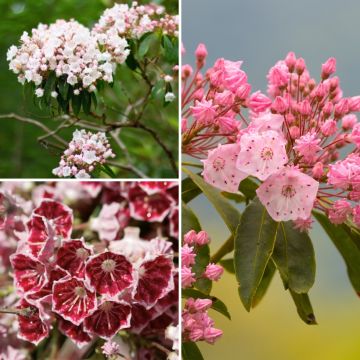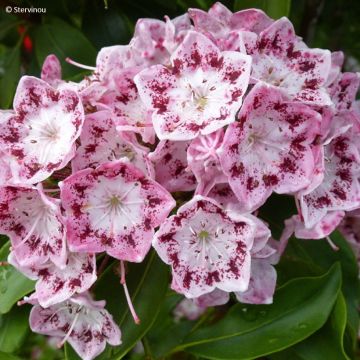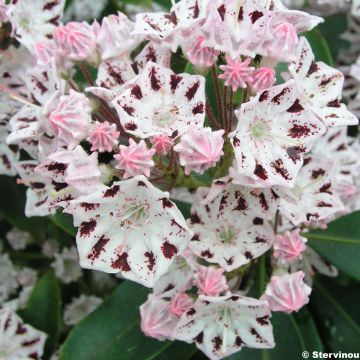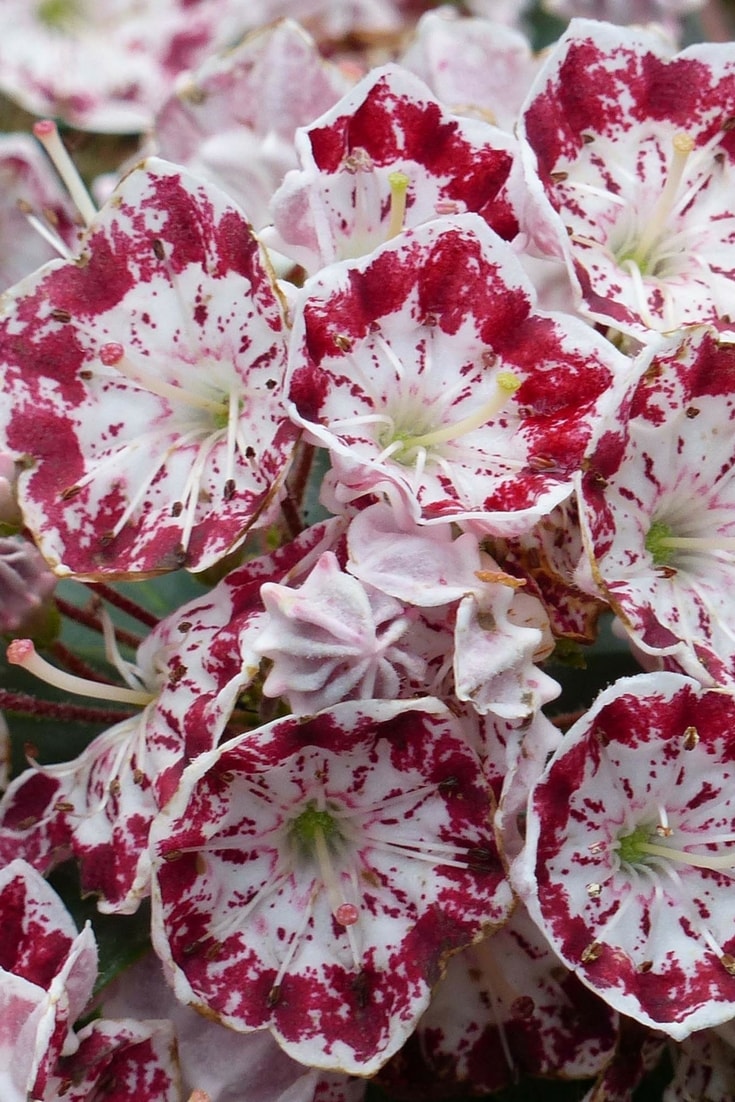
Kalmia latifolia : planting, growing and care
Contents
In a nutshell
- In May-June, it adorns itself with a multitude of flowers with an unparalleled delicacy of corollas
- It loves shade and acidity: it thrives in partial shade and in heather soil
- It retains its beautiful bright green evergreen foliage all year round
- With very slow growth, it is, however, very hardy down to -30°C
- Versatile, it can be used in borders, as a specimen, or in pots
A word from our expert
If you are familiar with Kalmia latifolia, a homeopathic remedy widely used for pain relief, Kalmia, also known as Mountain Laurel or American Laurel, is a beautiful, hardy bush that is unjustly overlooked. The most well-known species in the genus is Kalmia latifolia, which has numerous cultivars with varied colours. Its relative, Kalmia angustifolia, is more compact and does not exceed one metre in height. Less common, Kalmia microphylla is a dwarf species that is rarely cultivated in our gardens.
From April to May, Kalmia latifolia is covered with a multitude of corymbs of pink buds resembling small meringues, which bloom into pale pink to white corollas of infinite delicacy. Its beautiful, glossy green evergreen foliage serves as a backdrop for this fresh and generous flowering.
Original in appearance, it offers clusters of bright flowers in spring and brightens up shaded corners.
More demanding than its cousin the Rhododendron, it is, like it, acidophilous and requires heather soil, soft and cool, to thrive.
This understorey host is accommodating in light, acidic, cool but well-drained soil where it grows very slowly in the shade of trees, sheltered from cold winds and stagnant moisture.
With its reasonable size, bushy and compact habit, it adapts to all uses. It looks wonderful in a perennial bed, as a specimen, or even in a pot on a shaded terrace. It is the ideal companion for heather-loving plants such as Rhododendrons, Azaleas, Camellias, Heathers, Hydrangeas, Andromedas…
Remarkably floriferous, with its evergreen foliage, Kalmia is among the most beautiful heather-loving bushes. Discover our wide range and let yourself be charmed by its unique flowering!
Botany
Botanical data
- Latin name Kalmia
- Family Ericaceae
- Common name Mountain Laurel, American Laurel, Laurier des montagnes
- Flowering May-June
- Height 0.30 m for dwarf species to 3 metres for the tallest
- Exposure sun, partial shade
- Soil type Heather (Acidic)
- Hardiness -30°C
Kalmia is an evergreen bush that belongs to the Ericaceae family, like Heather and Rhododendron. Also known as Mountain Laurel or American Laurel, it is native to the forests, marshes, and meadows of North America. The genus includes seven species, the most well-known being Kalmia latifolia, which reaches 2 to 3 m in height in our gardens and has numerous cultivars with varied colours. Its relative, Kalmia angustifolia, is more compact with a rounded habit, not exceeding one metre in height and one metre in width. Less spectacular, Kalmia microphylla is a dwarf species (10 to 30 cm tall) that prefers wet and marshy areas.
Kalmia is a beautiful bush with a bushy and dense habit, somewhat erect, more or less branched depending on the species, that can reach 2 to 3 m in height and the same in width (up to 10 m in its natural habitat). Its trunk can become twisted, especially as it ages. The very hard wood of its branches was once prized, particularly for making wooden spoons, hence its English nickname of “Spoonwood”.
A bit slow to establish, Kalmia makes up for it with its longevity: some mother plants are around 60 years old! Its fine, shallow roots develop very slowly in the soil. As a result, it is well-suited to small gardens and city gardens and can also be grown in pots on a terrace. It will take many years to see it form true thickets (it grows about 1 m in ten years). Patience is rewarded by its truly unique flowering!
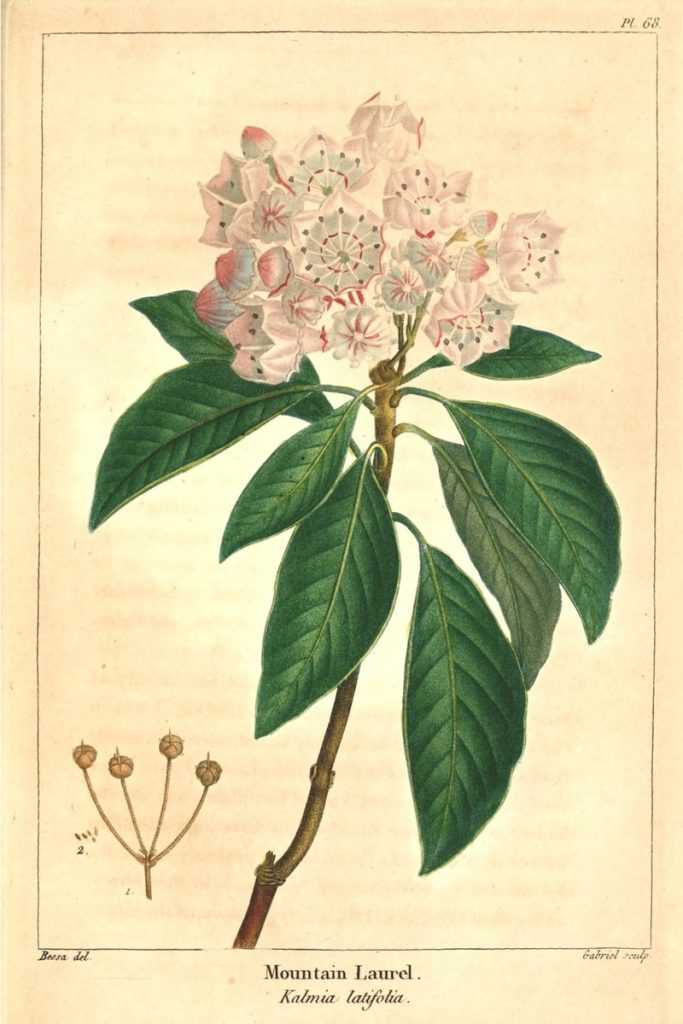
Kalmia latifolia: botanical plate
Its spring flowering is enchanting! Kalmia is completely covered, between May and June, with splendid flowers of very original design. A uniqueness that has made the flower of Kalmia latifolia the emblem of the states of Connecticut and Pennsylvania.
Emerging from pleated flower buds, dark pink or bright red, the flowers resemble small sugar tulips, opening into flat, very wide or campanulate cups, 2 to 2.5 cm in diameter, formed of 5 petals that spread around a heart bordered with purple or golden yellow stamens. They gather at the tips of the branches in generous clusters that can bear up to a hundred flowers. Of infinite delicacy, these somewhat waxy corollas come in all shades of pink, ranging from rosy white, red, pale pink to purplish pink with a darker reverse, evoking porcelain. Depending on the varieties, these bells take on a darker hue or are veined with radiating bands, as seen in Kalmia latifolia ‘You Can’. Some new cultivars, such as Kalmia latifolia ‘Tad’, even have flowers of a surprising chocolate colour.
An exquisite flowering that lasts a good month and is staggered: the beautifully veined flower buds like little meringues coexist with already opened flowers, creating a happy contrast. Not fragrant, they more than compensate for this lack of scent with their remarkable floribundity.

Foliage, bud and flowers
After flowering, brown, globular capsules persist in winter.
Kalmia offers a beautiful, graphic, and elegant foliage all year round. It forms interesting bushy clumps for their evergreen foliage, somewhat similar to that of Rhododendron or Laurel. Its foliage consists of small, glossy leaves 3 to 8 cm long, leathery and thick. Simple, alternate or opposite, lanceolate or elliptical depending on the varieties, they create a permanent backdrop of intense glossy green. The branches of some varieties, such as Kalmia latifolia ‘Pinkobello’, take on reddish hues that contrast beautifully with the foliage.
Despite its thick foliage and robust clump, Kalmia fears three things: direct sunlight, cold winds, and limestone.
In nature, this heather soil shrub thrives in semi-shaded areas, at the edge of woodlands where sunlight is filtered by trees. It appreciates exposure to the sun, a few hours in the morning or late afternoon.
While it tolerates a light sea breeze, planting along a wall or in woodland, sheltered from cold and drying winds to preserve its evergreen foliage is essential. On the other hand, it does not fear the cold. Kalmia is perfectly hardy and withstands temperatures down to -30°C, sometimes more, provided it is planted in a sheltered position.
Mountain Laurel can be found throughout France, preferring a cool, rainy oceanic climate: it loves freshness and high humidity.
While Kalmia is a low-maintenance shrub, it is demanding regarding soil type. If the soil does not suit it, it will decline. Like its cousin Rhododendron, Kalmia is a heather shrub that absolutely needs acidic, rather cool, humus-bearing but well-drained soil, and not limestone. Very sensitive to excess water, it fears the stagnant moisture of heavy, suffocating soils.
The genus Kalmia is dedicated to Pehr Kalm, a famous Swedish botanist of the 18th century, who was one of the first to explore the flora in certain parts of North America.
Very versatile, Kalmia can be used in free hedges with other heather soil shrubs, in borders with perennials, as a specimen, and even in pots: plant the taller varieties in a sheltered location to form a free hedge or dress a wall, alongside Rhododendrons, Camellias, Azaleas, Pieris, or Enkianthus. It will also be an ideal companion for Heathers, Hydrangeas, Japanese Maples, and Magnolias. Its very slow growth and the modest dimensions of some varieties allow it to be planted in pots: it will be a lovely decorative subject all year round with its glossy green evergreen foliage.
Read also
Plant young ericaceous plantsSpecies and varieties
The genus Kalmia includes seven species with varying sizes and flower colours. While the compact Kalmia angustifolia, which is broader than tall, can be found in commerce, the most cultivated and well-known species in our gardens is Kalmia latifolia, which has numerous cultivars in various shades of pink, mostly derived from North American breeding.
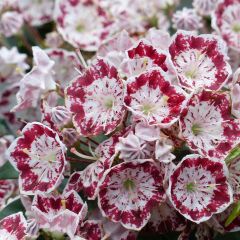
Kalmia latifolia Minuet - Mountain Laurel
- Flowering time June, July
- Height at maturity 1 m
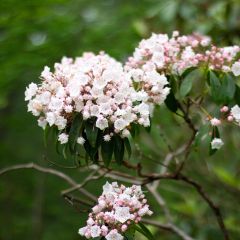
Kalmia latifolia - Mountain Laurel
- Flowering time June, July
- Height at maturity 2 m
/]
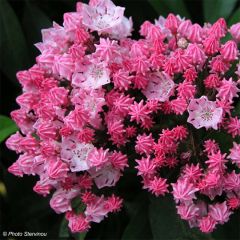
Kalmia latifolia You Can - Mountain Laurel
- Flowering time June, July
- Height at maturity 2 m
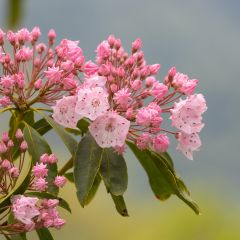
Kalmia latifolia Olympic Fire - Mountain Laurel
- Flowering time June, July
- Height at maturity 1 m

Kalmia latifolia Peppermint - Mountain Laurel
- Flowering time June, July
- Height at maturity 1,50 m
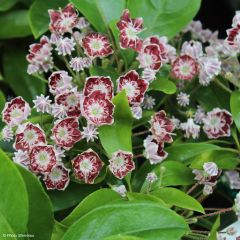
Kalmia latifolia Tad - Mountain Laurel
- Flowering time June, July
- Height at maturity 1 m
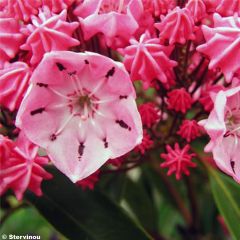
Kalmia latifolia Ewa - Mountain Laurel
- Flowering time June, July
- Height at maturity 1,30 m

Kalmia latifolia You Can - Mountain Laurel
- Flowering time June, July
- Height at maturity 2 m

Kalmia latifolia Minuet - Mountain Laurel
- Flowering time June, July
- Height at maturity 1 m

Kalmia latifolia Olympic Fire - Mountain Laurel
- Flowering time June, July
- Height at maturity 1 m
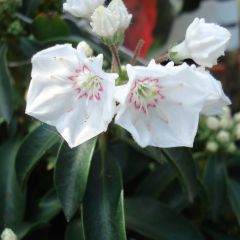
Kalmia latifolia Elf - Mountain Laurel
- Flowering time June, July
- Height at maturity 75 cm
- Kalmia angustifolia f. ‘rubra’ or Sheep Laurel: this is a smaller variety (0.80 m) with dark purple-red flowers that appear a little later in June-July.
- Kalmia latifolia ‘Ostbo Red’: its glossy green foliage serves as a backdrop for the bright red buds, then the pale pink flowers. Very compact.
- Kalmia latifolia ‘Carousel’: with white flowers striped with red in complex patterns.
- Kalmia latifolia f. fuscata ‘Freckles’: a purple cinnamon ring marks the inside of the white corolla.
Discover other Kalmias
View all →Available in 0 sizes
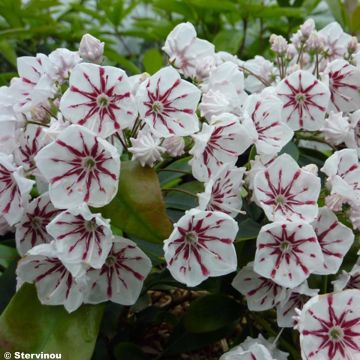
Available in 1 sizes
Available in 1 sizes
Available in 1 sizes
Available in 1 sizes
Available in 1 sizes
Available in 1 sizes
Available in 1 sizes
Available in 1 sizes
Available in 1 sizes
Planting Kalmia
Where to plant?
Kalmia needs shade and acidity to thrive. It fears scorching sun and even more so… the icy winds that damage its foliage. These are all factors to consider when installing it in the garden.
This bush can be planted almost anywhere in France, except perhaps south of the Loire, as it dreads the scorching sun in warm regions. It prefers soil that remains cool. It has a preference for cool, rainy climates, like that of Brittany, where it shows great vigour. In nature, most heather soil plants grow in undergrowth or at the edge of woodlands, where humidity is high. It can tolerate a sunny exposure for a few hours in the morning or late in the day.
It should be grown in a shaded corner of the garden, sheltered from direct sunlight, along a wall or under the dappled shade of large trees. Avoid overly dense shade, as it needs light to bloom well. Ideally, it likes west, south-west, or north-west exposures.
Very hardy, Kalmia is not afraid of the cold; it withstands temperatures down to -20° and tolerates sea air but fears storms and cold winds that scorch its evergreen foliage: planting it sheltered from cold drafts is necessary.
Easy to cultivate, Kalmia is, however, demanding regarding soil type: it requires acidity! It is an acidophilous plant that needs acidic soil, ideally close to heather soil and not calcareous to thrive.
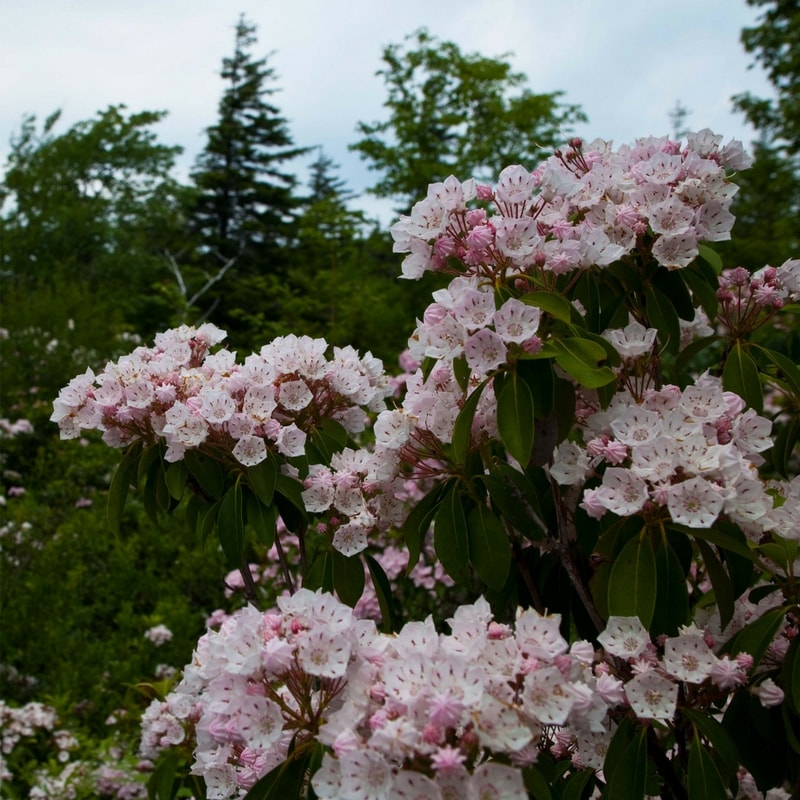 Kalmia latifolia: a bush that thrives in rather acidic soil
Kalmia latifolia: a bush that thrives in rather acidic soil
It also fears heavy, compact, suffocating soils and grows in cool, even moist terrain, but where water never stagnates: Kalmia is very sensitive to excess water, so avoid flooded areas, especially in winter. Excess water promotes contamination by Phytophthora, a soil-borne fungus, whose attack can kill it as suddenly as it is radical.
If your soil is too calcareous and/or too heavy, it is better to improve it with an addition of heather soil or… simply give up trying to alter Kalmia’s nature. Instead, consider a less demanding bush regarding soil type, lest you have to frequently add heather soil, only to end up with a sickly plant that is sensitive to fungal attacks.
You can opt for pot cultivation. Its small size makes this type of use perfectly suitable. It will thrive for many years in a large container filled two-thirds with heather soil and one-third with good non-calcareous garden soil, kept consistently moist.
Very versatile in the garden, Kalmia can be used in borders with perennials, at the edge of woodlands, in free hedges, or as a solitary plant or in a pot on a shaded terrace. Plant the tallest varieties in a sheltered wooded area to fill a hedge, while shorter plants like Kalmia latifolia ‘Minuet’ can be placed in a cool rockery or at the edge of flower beds exposed to partial shade. Growing very slowly, it is a compact bush that suits small gardens or urban gardens.
When to plant?
Kalmia can be planted all year round, avoiding periods of frost and drought. Ideally, to encourage its establishment, planting is preferred in autumn, from September to November in warm regions, and preferably in spring, in April-May, in the rest of the country.
How to plant?
Planting is the crucial step! The secret lies in the quality of the soil.
- Avoid calcareous soil: it would not survive. If you still wish to attempt its cultivation: replace the extracted soil with a mixture of heather soil, leaf compost, and peat. Calcareous soils cause yellowing of the foliage known as chlorosis in these bushes, which often leads to their death. You can also line the bottom and sides of the hole with a plant felt to prevent the rise of lime.
- Avoid areas where water stagnates: add gravel or pumice or a good layer of clay pebbles at the bottom of the hole to ensure good drainage (its roots do not like stagnant moisture, especially in winter, and are particularly sensitive to attacks from the Phytophthora fungus).
- Dig a hole 5 to 10 times wider than the root ball and 50 cm deep.
- Plant the bush at collar level, in a mixture ideally composed of 1/5 of loamy soil mixed in equal parts with peat, heather soil, leaf compost, and pumice.
- Spread an organic mulch of pine bark 8-10 cm thick or plant small perennials to protect the base and limit watering: it likes its roots to be kept cool during summer.
- Water regularly with non-calcareous water (rainwater), but without excess, during the first weeks following planting to keep the soil moist and cool. During the first year after planting, especially in summer and in case of drought, water abundantly.
Container gardening
Kalmia is a bush that is very well suited for pot cultivation. We recommend opting for dwarf varieties such as Kalmia latifolia ‘Minuet’. Be sure to prepare a fresh, very well-draining mix based on genuine heather soil and well-decomposed compost, as it cannot tolerate stagnant moisture. Choose a large container of about thirty litres (30 to 40 cm in diameter) and create a bed of gravel or clay pebbles at the bottom. In a pot, it will not tolerate even temporary drought. Kalmia needs water all year round, and if grown in a pot, close monitoring of watering will be essential. Spread a mulch or plant small perennials like dwarf cyclamen to maintain moisture.
Maintenance, pruning and care
A well-established Kalmia requires little care to maintain its good health. Each spring, at the end of winter, you can incorporate a bit of compost by superficial scratching around the base to maintain the fertility of the substrate. It is also possible to apply a special heather soil fertiliser.
Then, spread a layer of organic mulch (bark or pine needles, leaf mat), renewed each year, to keep its roots cool during the summer heat.
The Kalmia needs water in summer but is sensitive to excess water in winter. In summer: water 2 to 3 times a month, no more, with non-calcareous water. For this calcareous intolerant, prefer rainwater.
Slow-growing, its pruning is unnecessary. Only intervene to remove any dead branches or to carry out a very light refreshment to maintain a balanced habit. Remove faded flowers after flowering to prevent seed formation that depletes the plant.
Possible diseases
Cultivated under good conditions, Kalmia is relatively resistant to diseases and pests.
It is primarily threatened by cryptogamic diseases caused by fungi. These issues generally arise from poorly drained soil or stagnant moisture around the roots. Its main enemy is Phytophthora, a soil-borne fungus whose attack can kill it as suddenly as it is radical.
Phytophthora, literally “plant destroyer” in Greek, thrives in conditions of persistent moisture, often exacerbated by overly frequent watering. The foliage discolours, browns, or reddens, and then dries out. The plant then dies quickly. There is no control method, but these issues are rare if cultivation advice is followed: plant in healthy soil, avoid excess water in the soil, and improve drainage. If, despite these precautions, an attack occurs: uproot the affected plants and remove the soil surrounding their roots. Never replant sensitive species in the same spot.
Intolerant of lime, Kalmia’s leaves discolour and yellow in the presence of excess lime (chlorosis). The culprit may simply be the watering water. Water only with rainwater.
Multiplication
- By semi-hardwood cuttings
After flowering, in July-August, take semi-woody or semi-hardwood shoots of 10 to 20 cm (that is, from stems that have grown in spring and begin their transformation from softwood to hardwood from July-August). Plant them in a light, well-draining substrate. Regularly mist the cuttings with a spray bottle. Transplant them into buckets as soon as they have formed roots. Winter them in a frost-free environment: a constant temperature of at least 20°C is essential for rooting in 8 to 10 weeks. Plant them in the ground the following spring, if the root development is sufficient.
- By herbaceous cuttings
Herbaceous cuttings are generally taken in spring, in May. Cut a stem just below a leaf or an eye. Remove the leaves from the base. Plant in pots or trays in a substrate composed of garden soil and river sand. Regularly mist the cuttings and keep them sheltered at a temperature of at least 20°C. Transplant them into individual pots, then into the ground when the root system is sufficiently developed. It may require several winters.
- By layering
While layering is the least tedious method for multiplying Kalmia, it requires patience: root development is very slow. In August, lay one of its shoots down by tilting it towards the ground, burying part of it to encourage rooting. Stake the aerial part. In autumn or the following spring, you can separate the layer from the mother plant when it has enough roots, by cutting the stem at the point where it enters the soil.
Associate Kalmia
Very versatile, Kalmia can be used both in free hedges with other heather soil bushes, and in borders with perennials, as a specimen plant, or even in pots: plant the taller varieties in a sheltered location to create a free hedge or dress a wall, alongside Rhododendrons, Camellias, Azaleas, or Enkianthus. It will also be an ideal companion for Heathers, Hydrangeas, Hydrangeas, Japanese Maples, Magnolias, or Andromedas, Sarcococcas, Daphnes, or Skimmias.

Pair Kalmia with Magnolia Fairy Blush® (Michelia hybrid) or Magnolia sieboldii
Its very slow growth and the modest size of some varieties allow it to be planted in pots: it will be a lovely decorative subject all year round with its evergreen, glossy green foliage.
→ Discover more pairing ideas with Kalmia in our advice sheet!
Useful resources
- Discover our tips for successfully growing Kalmia in pots
- What to pair with your Kalmia? Choose from our heather soil plants
- Our advice sheet is perfect for learning how to properly plant heather soil bushes
- The most beautiful range of Kalmia is with us
- 5 tips to succeed with heather soil bushes: on our blog, Michaël, our Head Gardener, shares his secrets
Frequently asked questions
-
Can I still plant a Kalmia in heavy, slightly calcareous soil?
Yes, but it's not a done deal! Kalmia is a heather soil bush, a cousin of the Rhododendron, that thrives in areas without limestone. Its leaves discolour and turn yellow in the presence of excess limestone (chlorosis). It is also sensitive to heavy, compacted soils that are waterlogged, especially in winter. It prefers light and cool soils in summer. Excess water promotes contamination by Phytophthora, whose attack can kill it as suddenly as it is radical. If your soil is too calcareous and/or too heavy, consider opting for a less demanding bush regarding soil type, or you may find yourself frequently needing to add heather soil, only to end up with a sickly plant that is prone to diseases. If you still wish to attempt its cultivation, prepare the soil with a substrate made up of equal parts heather soil or turf, potting soil, and my topsoil, lining the bottom and sides of the hole with a plant felt to prevent the rise of limestone.
-
In the ground for two years, my Kalmia isn't shooting!
It's normal. Kalmia is very slow to establish: its roots develop very slowly in the soil. It will take many years to see it form a proper bush, as it grows about 1 m in ten years. Patience is rewarded by its flowering, which is truly unique!
-
My Kalmia died suddenly after two years, why?
Several explanations are possible. It died from excess water; its roots cannot tolerate stagnant moisture that promotes the proliferation of Phytophthora, a fungus whose attack can kill it as suddenly as radically. It is too exposed to the sun: dappled light is enough for its happiness. It fears the scorching sun during the hottest hours of the day. Move it to partial shade, under a sun filtered by large trees.
-
My Kalmia is languishing, losing its leaves which are turning yellow before falling. Why?
Kalmia enjoys being fed annually on the surface with decomposed compost and leaf mould, as the soil may be too poor for it. Intolerant to lime, its leaves discolour and turn yellow in the event of excess lime (chlorosis). The culprit may simply be the watering water. Water only with rainwater.
- Subscribe!
- Contents































